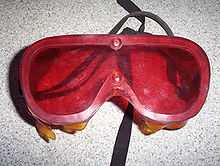Red adaptation goggles

Red adaptation goggles, sometimes called dark adaptor goggles, were first invented by Wilhelm Trendelenburg in 1916 for early radiologists to use to adapt their eyes to view the light produced by fluorescent screens during fluoroscopic procedures.
Such goggles or glasses are often used by pilots and weather observers to preserve their natural night vision.
Concept
The concept is based on the work by Antoine Béclère on dark adaptation of the eye, where it is noted that fluoroscopy relies on the use of the retinal rods of the eye.
Since retinal rods are insensitive to long wavelengths of light, such as red light, while retinal cones are not, the goggles enabled the physicians to adapt their eyes in preparation for the fluoroscopic procedure while still being able to perform other work.
Prior to the invention of these goggles, physicians were required to sit in the darkened room where the procedure would be performed for extended periods to adapt their eyes to the low lighting conditions.
References
External links
- "Red Goggles (ca. 1940s)". Oak Ridge Associated Universities. Retrieved 2008-07-14.